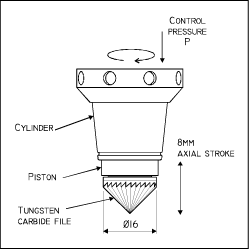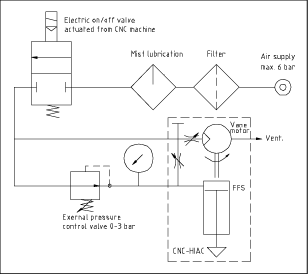CNC-Hiac
Operation/Specifications
 The FFP or Free Flying Piston,
is an important part of the CNC-Hiac.
The FFP or Free Flying Piston,
is an important part of the CNC-Hiac.
The FFP is pushed
forward into contact with the burr edge by use of an adjustable air pressure.
The air vane motor is decoupled from the linear movement of the FFP, to reduce
inertia and increase the stability of the contact force when deburring.
The spline coupling transmits torque to the rotary file.
Ball bearings ensure
an even running of the tungsten carbide file. A very little friction torque
is transmitted through the ball bearings to the FFP cylinder, which rotates
slowly inside the stationary outer cylinder. Thus stick-slip or static friction
of the FFP is avoided. The FFP cylinder is in addition precision ground to
ensure very little friction in the axial direction.

The internal pneumatic
diagram for the CNC-Hiac is shown to the right.
The axial force can
be easily adjusted by applying a screwdriver to a directly accessible integral
needle valve, until a chamfer with the desired width is produced for a given
path speed. An extra small axial force can be obtained by removing a plug.
The CNC-Hiac tool
has one air supply port that is common for both vane motor and axial force
control. The air supply should be mist lubricated, but must not contain any
cutting fluid or coolant.
The exhaust air is
vented directly to atmosphere. The CNC-Hiac tool therefore has a compact type
integral air silencing system consisting of felt pads in five small chambers.
The CNC-Hiac fits
into a 1-1/4" shank, e.g. a 1-1/4" Weldon holder. The CNC machine
must be able to supply air through the spindle (the air normally used to clean
tools in the tool-change system) and include the possibility to program an
air supply on/off function. The spindle carrying the CNC-Hiac must not rotate
at all.
Specifications:
- Motor: Air motor, vane type.
- Speed: Idle 30,000 rpm, operating
18-25,000 rpm.
- Torque: 0.4 Nm at lower speeds.
- Power: 250 W at 20,000 rpm.
- Compensation, due to burr inaccuracy:
max. +/-4mm in/out and sideways, recommended to use +/-2 mm.
- Axial force adjustable at 5 bar
inlet press.
- Normal range: 9.5 - 25 N.
- Light range: 3.5 - 6.5
- Path speed: maximum 100mm/sec.
- File surface speed: 7.5 - 10.5
m/sec. measured at radius 4 mm (halfway between tip and outer rim).
- Mounting: Fits into 1-1/4" shank,
e.g. 1-1/4" Weldon holder.
- Air supply: 5 bar (max 6 bar)
through CNC machine tool spindle.
- Air consumption: Appr. 400 I/min,
at 5 bar pressure.
- Sound pressure level: approx.
78 dB(A).
- Rotary file burrs: Tungsten carbide
type, diameter 16mm (1) 90° coned shape, straight fluting.
(2) 90° coned shape, spiraled
fluting. (3) Flowerburr, end miller with
contact point.
- Other rotary file/burr types upon
request.
- Special tools: Burr change tool.
- Weight total: 0.96 kg.
- Weight FFP with file: 50 g.
Top
/ Return to CNC Hiac page / Return to main Speedeburr page
|